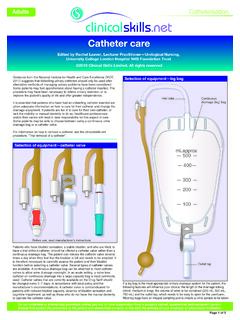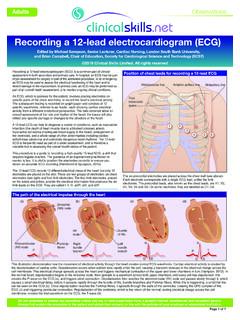Transcription of Medicines administration via a gastrostomy or percutaneous ...
1 ProtouchProtouch350 AmbidextrousPowder-free non-sterileNitrile examination gloves100 PCSRef:SizeLarge350 AmbidextrousPowder-free non-sterileNitrile examination glovesRef:SizeLarge100 PCSWhen caring for patients who are not able to take medication orally, it is common practice to administer Medicines via a gastrostomy tube, such as a percutaneous endoscopic gastrostomy (PEG) tube. Patients who are fed via a gastrostomy tube often cannot manage any type of oral intake, and this includes medications. There are, however, problems associated with this practice. Those prescribing and/or administering medication in this way should be aware of possible interactions and issues of liability. Always consult a pharmacist for advice on the appropriateness of delivering medication to individual patients via a gastrostomy tube.
2 The Handbook of Drug administration via Enteral Feeding Tubes (White & Bradnam, 2015) is also a useful resource. These pages show the ENFit connector, an internationally agreed standard that aims to reduce misconnections between unrelated delivery systems, such as vascular, respiratory and epidural systems (GEDSA, 2017).LiabilityThe product licence of a medication indicates the conditions under which a medicine can be safely administered. Anyone administering a medicine outside of those conditions assumes a degree of liability for any adverse effects (MHRA, 2009). For example, crushing a tablet that was designed to be swallowed whole means that the administration falls outside of that medicine s product licence. Nevertheless, it is generally accepted that, in certain circumstances, the practice of crushing tablets, or giving other oral preparations via enteral feeding tubes, is unavoidable in enabling professionals to act in the patient s best interest.
3 The prescription chart must indicate that the patient is receiving medication via a gastrostomy tube (MHRA, 2009). InteractionsThe timing of medicine administration can interfere with the absorption and effect of the medicine and may be a factor in treatment failure. Therefore, it is important that the person administering medication is aware of any potential interactions and any required time-gap between medication and feed. Never add Medicines to enteral feed containers, because of the risk of unknown interactions and the unpredictability of administration of enteral medicine must be given individually; Medicines must not be crushed or mixed together. This is extremely important in preventing unknown interactions. There should be a flush of at least 10 15 mL of water, according to local policy, between each medicine administered, to ensure they do not mix within the feeding tube (BAPEN, 2003).
4 Medicine preparationsA soluble or liquid formulation is preferred when Medicines are to be given via a PEG tube. However, some liquid Medicines are suspensions which contain small particles that can block tubes. Crushing tablets or opening capsules is a last resort; you should first discuss this option with a pharmacist. Some tablets that are not marketed as dispersible will, in fact, dissolve in water if given enough time, and a pharmacist will be able to advise on this strategy. Tablets that should not be crushed include: Enteric-coated (EC): the coating is designed to resist gastric acid, to protect the medicine and/or reduce gastric side-effects. Modified/slow-release (MR, SR, LA, XL): tablets or capsules that are designed to release the medicine over an extended period of time; crushing will release all the medicine at once and may cause toxic side-effects.
5 Cytotoxic Medicines and hormones: these should not be crushed due to the risks to staff from exposure to the powdered medicine. Sublingual, buccal, melt and chewable preparations. Proton pump inhibitors: these have coatings that are designed to dissolve in the jejunum rather than the stomach (BAPEN, 2003).The gastrostomy tube must be flushed with at least 30 mL of fresh water before administration of medicine; refer to local policy to see what sort of water is recommended (it could be sterile or tap water) (Thompson, 2017).Page 1 of 3 NutritionAdultsMedicines administration via a gastrostomy orpercutaneous endoscopic gastrostomy (PEG) tubeDemonstrated by Jane Fletcher, Nutrition Nurse Team Leader, Queen Elizabeth Hospital, University Hospitals Birmingham NHS Foundation Trust 2019 Clinical Skills Limited.
6 All rights reservedDo not undertake or attempt any procedure unless you are, or have supervision from, a properly trained, experienced and competent first explain the procedure to the patient and obtain their consent, in line with the policies of your employer or educational on an apron, decontaminate your hands and put on gloves (Loveday et al., 2014), according to local your hands Medicines pot50/60-mL enteral syringeMedication135792468212345mlNon-st erile gloves Apron5-mL enteral syringeUse clearly labelled oral or enteral syringes (which are usually purple) for the oral/enteral administration of liquids, to reduce the risk of accidental parenteral administration (NPSA, 2007). 102030405060m2 EnteralGlass of water135792468212345mlReg.
7 No. H402054/A NHS No. 5957276904 Name PRIESTLY Class OLOS 3 Age 48y Sex F Loc GAMBS ystem Prescription Action View Patient Print HelpPrescribing Information & Communication SystemCons FRAA Pat No Pat List Pat Srch Bed Hand Over DepPat Admin Procedures Requests Flowsheet Observations Classify Drug Round Prescription Drug Chart Alert List Misc ResInfusionsCurrent DrugInfusions Recent Drugs Current Drug AllChemoChemoRecent Drugs02 07 10 12 14 17 22 02 07 10 12 14 17 22 02 07 10 12 14 17 22 02 07 10 12 14 17 22 02 07 10 12 14 17 22 02 07 10 12 14 17 22 02 07 10 12
8 14 17 2202 .12 compression stockings(GECS)135792468212345ml Nutrition AdultsMedicines administration via a gastrostomy /PEG tube Page 2 PrescriptionMeasure liquid Medicines with a syringePreparing the medicine: (a) Liquids(b) Soluble tablets(c) Tablets(d) CapsulesShake liquid Medicines well. Use a small enteral syringe to accurately measure small doses of liquid Medicines . If available, use a bottle bung in the medication bottle and attach the syringe to it; this will make drawing up the medication easier and reduce the risk of spillages. Alternatively, a medication straw may be used to withdraw the medicine from the bottle.
9 Place small doses of liquid Medicines into a Medicines pot and dilute with 10 15 mL of fresh water, according to local policy. Dilute thick liquids with an equal amount of administering tablets that are soluble, dissolve these in 10 15 mL of water. If there are no alternative preparations available, crush uncoated and sugar-coated tablets using a suitable tablet-crushing device or pestle and mortar, and mix the powder with 10 15 mL of 2 of 3Do not undertake or attempt any procedure unless you are, or have supervision from, a properly trained, experienced and competent first explain the procedure to the patient and obtain their consent, in line with the policies of your employer or educational check the patient s identity and their current prescription before giving a medicine.
10 The prescription must show the correct route of administration , , gastrostomy . Before administering Medicines via a gastrostomy tube, you must flush it with 30 mL of fresh water (see inset). Always refer to local policy and guidelines. If there are no alternative preparations available, and if advised to do so by a pharmacist, open capsules, tip the powder into the Medicines pot and mix it with 10 15 mL of Enteral135792468212345ml102030405060ml2 EnteralTo increase flow, raise the syringeTo decrease flow, lower the syringe2 Enteral 102030405060102030405060ml2 Enteral2 Enteral102030405060m2 / Enteral 2102030405060ml2 EnteralNutrition AdultsMedicines administration via a gastrostomy /PEG tube Page 3 Measure the water for dilutingMix the medicine Attach the syringe to the tubeAdminister the medicine: (a)(b)Repeat the procedure if necessaryMake sure you mix the medicine and water together well.










